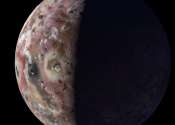NASA hears from Voyager 1, the most distant spacecraft from Earth, after months of quiet
NASA has finally heard back from Voyager 1 again in a way that makes sense.

NASA has finally heard back from Voyager 1 again in a way that makes sense.
Planetary Sciences
Apr 27, 2024
1
76

Scientists on NASA's Juno mission to Jupiter have transformed data collected during two recent flybys of Io into animations that highlight two of the Jovian moon's most dramatic features: a mountain and an almost glass-smooth ...
Planetary Sciences
Apr 18, 2024
0
363

An international team of astronomers reports the detection of a new young and warm exoplanet orbiting a distant star. The newfound alien world, designated TOI-4862 b (or NGTS-30 b), is similar in size and mass to Jupiter. ...

Astronomers are pretty sure they know where the moon came from. In the early solar system, a Mars-sized object dubbed Theia smashed into Earth. This cataclysmic collision knocked a huge mass of material into orbit, which ...
Planetary Sciences
Apr 4, 2024
1
37

For nearly 50 years, NASA's Voyager 1 mission has competed for the title of deep space's little engine that could. Launched in 1977 along with its twin, Voyager 2, the spacecraft is now soaring more than 15 billion miles ...
Space Exploration
Mar 18, 2024
1
258

The largest and nearest of the giant outer planets, Jupiter's colorful clouds present an ever-changing kaleidoscope of shapes and colors. This is a planet where there is always stormy weather: cyclones, anticyclones, wind ...
Planetary Sciences
Mar 14, 2024
0
17

Astronomers report the discovery of a new warm Jupiter exoplanet orbiting a distant star in the open cluster Messier 67. The newfound extrasolar world, designated S1429 b, is almost twice as massive as Jupiter. The finding ...

In 2008, astronomers with the SuperWASP survey spotted WASP-12b as it transited in front of its star. At the time, it was part of a new class of exoplanets ("hot Jupiters") discovered a little more than a decade before. However, ...
Planetary Sciences
Mar 11, 2024
0
53

Jupiter is our solar system's undisputed king of the planets. Jupiter is bright and easy to spot from our vantage point on Earth, helped by its massive size and banded, reflective cloud tops. Jupiter even possesses moons ...
Planetary Sciences
Feb 15, 2024
0
39

The Juno spacecraft has revealed some fascinating things about Jupiter since it began exploring the system on July 4th, 2016. Not only is it the first robotic mission to study Jupiter up close while orbiting it since the ...
Planetary Sciences
Feb 6, 2024
0
51
Jupiter is the fifth planet from the Sun and the largest planet within the Solar System. It is a gas giant with mass slightly less than one-thousandth that of the Sun but is two and a half times more massive than all of the other planets in our Solar System combined. Jupiter is classified as a gas giant along with Saturn, Uranus and Neptune. Together, these four planets are sometimes referred to as the Jovian planets.
The planet was known by astronomers of ancient times and was associated with the mythology and religious beliefs of many cultures. The Romans named the planet after the Roman god Jupiter. When viewed from Earth, Jupiter can reach an apparent magnitude of −2.8, making it on average the third-brightest object in the night sky after the Moon and Venus. (Mars can briefly exceed Jupiter's brightness at certain points in its orbit.)
Jupiter is primarily composed of hydrogen with a quarter of its mass being helium; it may also have a rocky core of heavier elements. Because of its rapid rotation, Jupiter's shape is that of an oblate spheroid (it possesses a slight but noticeable bulge around the equator). The outer atmosphere is visibly segregated into several bands at different latitudes, resulting in turbulence and storms along their interacting boundaries. A prominent result is the Great Red Spot, a giant storm that is known to have existed since at least the 17th century when it was first seen by telescope. Surrounding the planet is a faint planetary ring system and a powerful magnetosphere. There are also at least 63 moons, including the four large moons called the Galilean moons that were first discovered by Galileo Galilei in 1610. Ganymede, the largest of these moons, has a diameter greater than that of the planet Mercury.
Jupiter has been explored on several occasions by robotic spacecraft, most notably during the early Pioneer and Voyager flyby missions and later by the Galileo orbiter. The most recent probe to visit Jupiter was the Pluto-bound New Horizons spacecraft in late February 2007. The probe used the gravity from Jupiter to increase its speed and adjust its trajectory toward Pluto, thereby saving years of travel. Future targets for exploration in the Jovian system include the possible ice-covered liquid ocean on the moon Europa.
This text uses material from Wikipedia, licensed under CC BY-SA